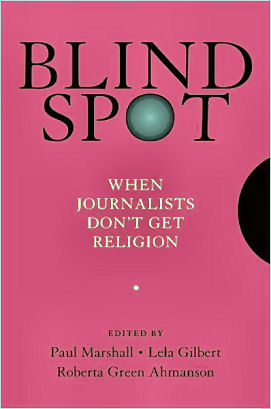
|
Posted August 4, 2009
Book: Blind Spot: When Journalists Don’t Get Religion Edited by Paul Marshall, Lela Gilbert, Roberta Green Ahmanson Oxford University Press. Cambridge, MA. 2009. Pp. 220 An Excerpt from the Jacket:
Blind Spot’s essays examine news stories reported by major media sources in which key religious dimensions were ignored, overlooked, or misrepresented. These stories range from the 2004 U.S. presidential elections to Iran, Iraq, and the papal succession. Blind Spot offers all readers — whether people of faith or not — an interesting and balanced analysis of the news media’s uneasy relationship with religion and religious causes. An Excerpt from the Book: The media had an enormous job on its hands in covering the death of John Paul II and the election of Benedict XVI. As a whole, it did an adequate and sometimes outstanding job, drawing a global audience into the richness of Catholic liturgical life and spirituality, often with illuminating commentary, especially from the broadcast and cable news networks. It was, at times, television news at its best. But telling those stories was a struggle for print, broadcast, and cable media, for many of the same reasons religion coverage is a struggle in general: media organizations don’t prioritize or finance adequate ongoing coverage or the hiring of competent, knowledgeable full-time religion reporters. Reporting on Catholicism has its own challenges, as we have seen, mostly due to the breadth, historical depth, and complexity of the Catholic world. Those news sources covering the Catholic Church can improve their coverage only if they deepen their knowledge of the Church. This does not mean becoming advocates or losing their objectivity. It means nurturing journalists who understand the history of Catholicism, the nature of authority, and the role of the pope and bishops in the Church. It means reporting on decisions and practices within thier proper context. It means understanding the Catholic sense — what is happening on the ground and what ordinary Catholic believers say and think and do. One primary obstacle that media organizations face in deepening their coverage is reliance on a handful of regularly used experts to “explain” the Catholic scene. This is problematic not only because of the dull and routine stories that result, in which we can be assured, for example, taht we will see Fr. Thomas Reese, S.J., Fr. Richard McBrien, Fr. Richard John Neuhaus, and perhaps Bill Donahue of the Catholic League quoted. It is problematic also because it falls into the trap of letting the experts, who like to promote a view that Catholics think a certain way, shape reality. Table of Contents: Part I Background 1. God is winning: religion in global politics, II Part II Case Studies 2. Religion and terrorism: misreading al Qaeda 3. Three decades of misreporting Iran and Iraq 4. The Faith-Based Human Rights Quest: Missing the story 5. “Misunderstanding” religion in the 2004 Presidential Campaign 6. The Popes 7. Jesus Christ, superstar, The Passion of the press Part III Getting it Right 8. Getting it right in the newsroom 9. Getting it right |
|
